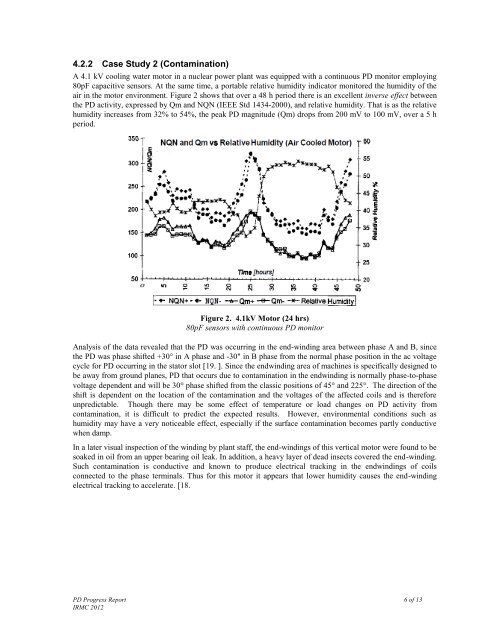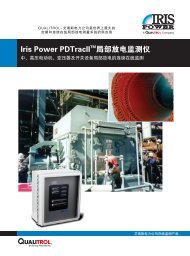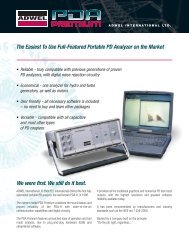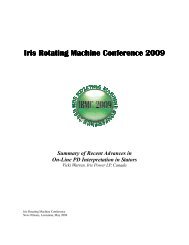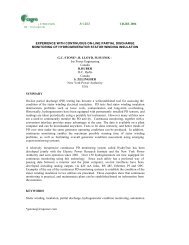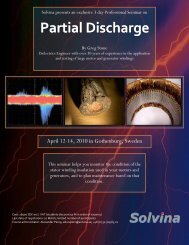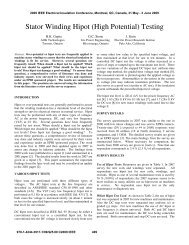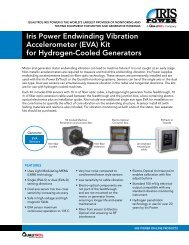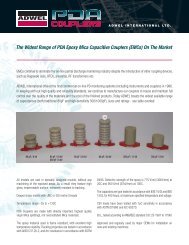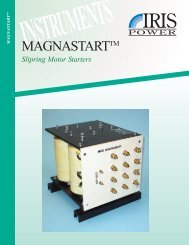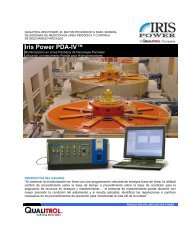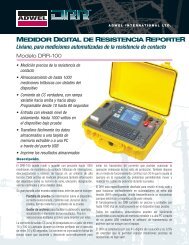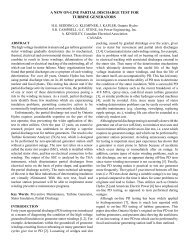partial discharge testing: a progress report - Iris Power Engineering
partial discharge testing: a progress report - Iris Power Engineering
partial discharge testing: a progress report - Iris Power Engineering
You also want an ePaper? Increase the reach of your titles
YUMPU automatically turns print PDFs into web optimized ePapers that Google loves.
4.2.2 Case Study 2 (Contamination)<br />
A 4.1 kV cooling water motor in a nuclear power plant was equipped with a continuous PD monitor employing<br />
80pF capacitive sensors. At the same time, a portable relative humidity indicator monitored the humidity of the<br />
air in the motor environment. Figure 2 shows that over a 48 h period there is an excellent inverse effect between<br />
the PD activity, expressed by Qm and NQN (IEEE Std 1434-2000), and relative humidity. That is as the relative<br />
humidity increases from 32% to 54%, the peak PD magnitude (Qm) drops from 200 mV to 100 mV, over a 5 h<br />
period.<br />
Figure 2. 4.1kV Motor (24 hrs)<br />
80pF sensors with continuous PD monitor<br />
Analysis of the data revealed that the PD was occurring in the end-winding area between phase A and B, since<br />
the PD was phase shifted +30° in A phase and -30" in B phase from the normal phase position in the ac voltage<br />
cycle for PD occurring in the stator slot [19. ]. Since the endwinding area of machines is specifically designed to<br />
be away from ground planes, PD that occurs due to contamination in the endwinding is normally phase-to-phase<br />
voltage dependent and will be 30 phase shifted from the classic positions of 45 and 225 . The direction of the<br />
shift is dependent on the location of the contamination and the voltages of the affected coils and is therefore<br />
unpredictable. Though there may be some effect of temperature or load changes on PD activity from<br />
contamination, it is difficult to predict the expected results. However, environmental conditions such as<br />
humidity may have a very noticeable effect, especially if the surface contamination becomes partly conductive<br />
when damp.<br />
In a later visual inspection of the winding by plant staff, the end-windings of this vertical motor were found to be<br />
soaked in oil from an upper bearing oil leak. In addition, a heavy layer of dead insects covered the end-winding.<br />
Such contamination is conductive and known to produce electrical tracking in the endwindings of coils<br />
connected to the phase terminals. Thus for this motor it appears that lower humidity causes the end-winding<br />
electrical tracking to accelerate. [18.<br />
PD Progress Report 6 of 13<br />
IRMC 2012


